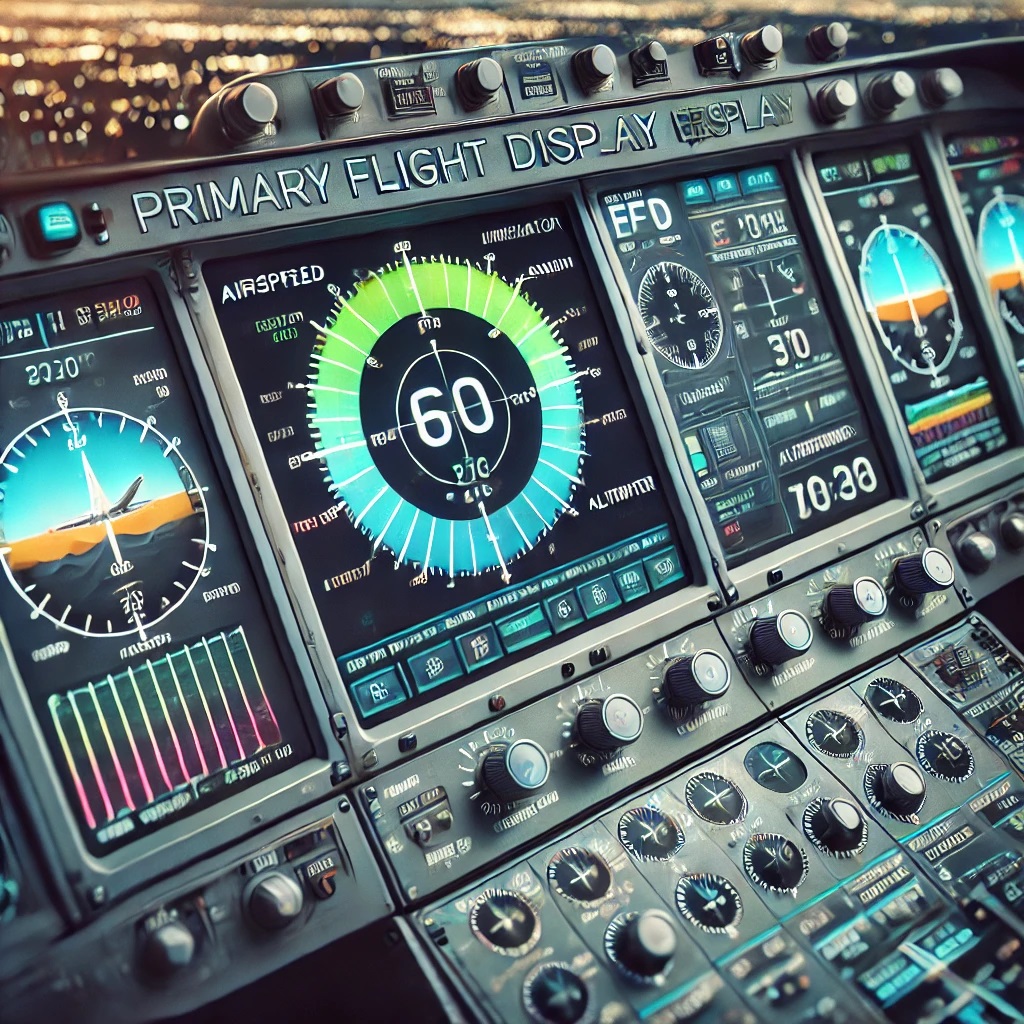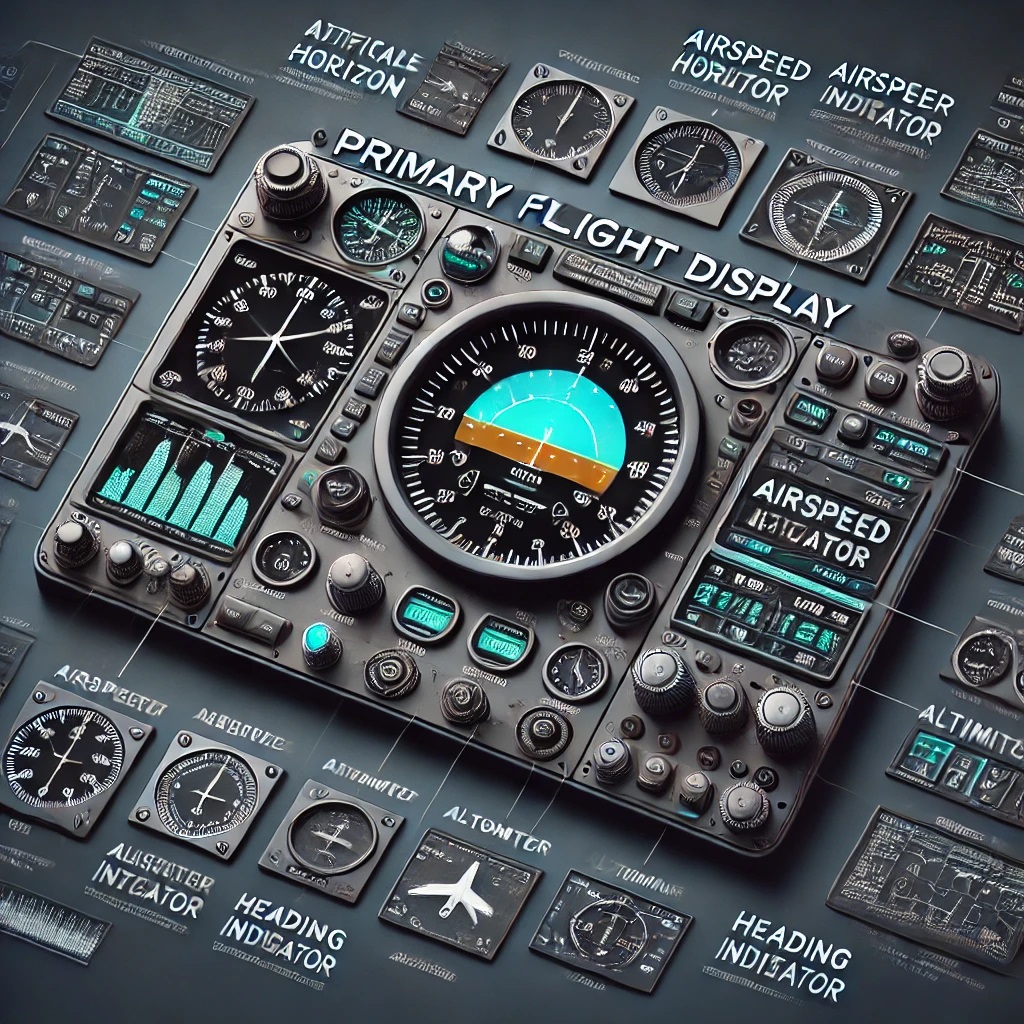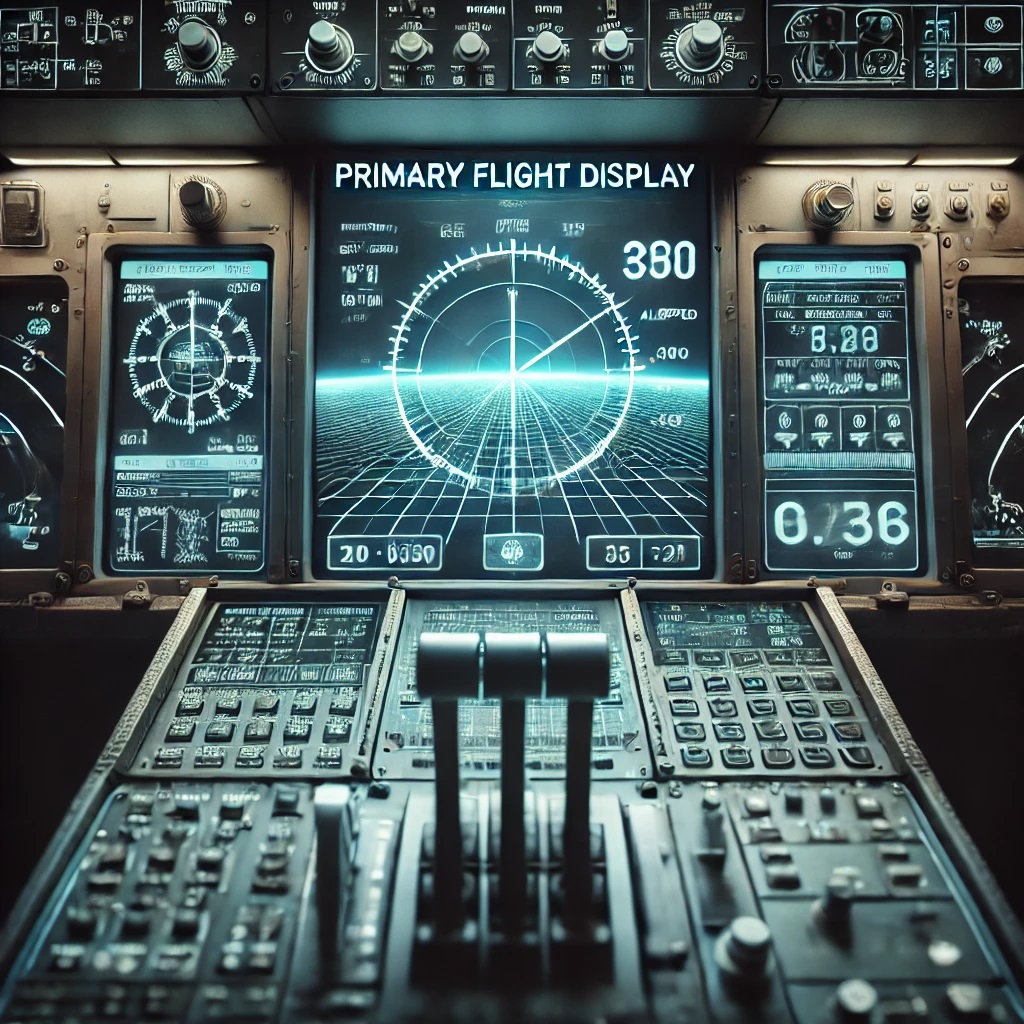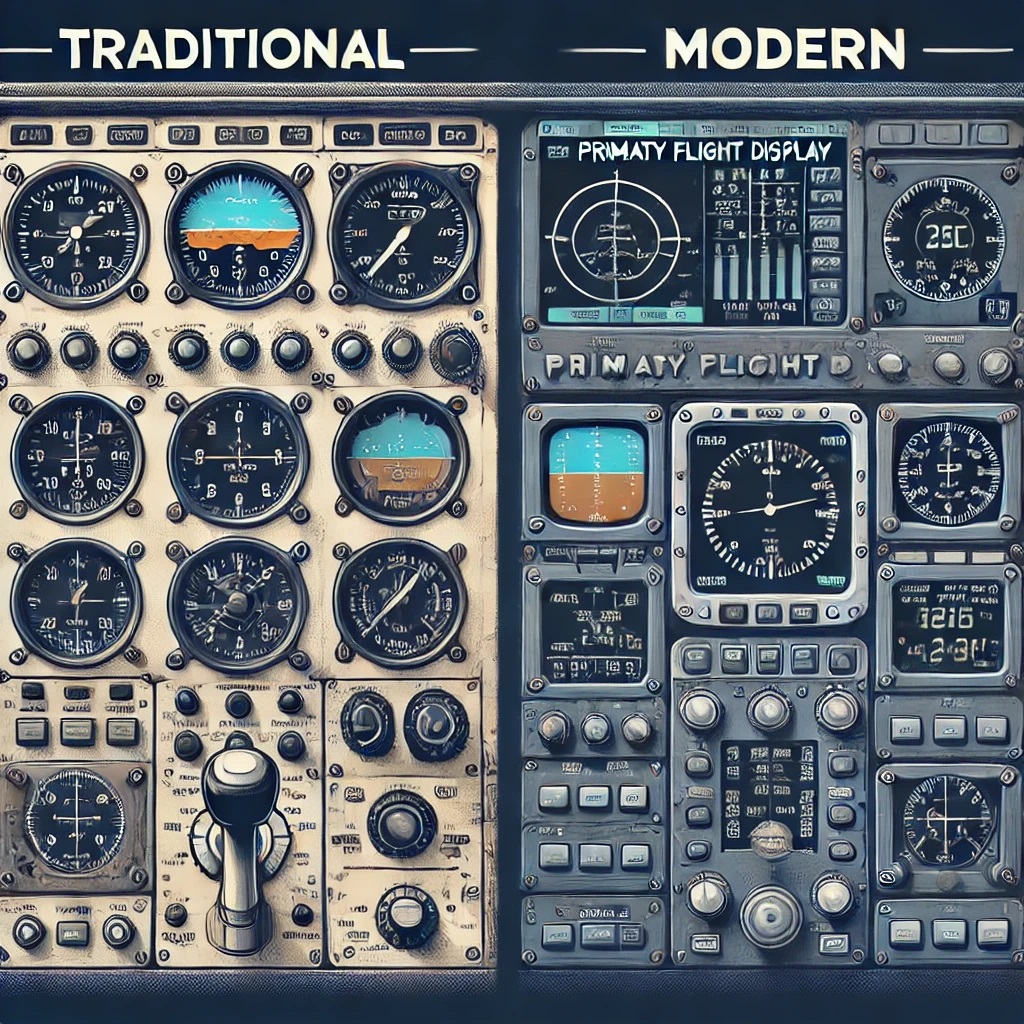What is Primary Flight Display – Essential Guide to Aviation Technology:

Primary Flight Displays, also known as PFDs, are a big deal in the world of aviation. They basically serve as the airplane’s dashboard, bringing together all the critical flight data into one screen. You’ll find them in just about every modern aircraft cockpit, helping pilots make quick, informed decisions.
PFDs have come a long way since the early days of aviation. Back in the day, pilots relied on a bunch of individual instruments, each showing a specific piece of info like altitude or airspeed. It required a lot of scanning and interpretation, which wasn’t always ideal during tense moments. But with PFDs, the essential details are displayed in an integrated format allowing for swift comprehension.
The importance of a Primary Flight Display can’t be overstated. It streamlines the flying experience by reducing the need for constant scanning and interpretation of multiple instruments. This becomes especially critical in situations where quick decision-making can make all the difference, such as during takeoffs, landings, or turbulent weather conditions.
By consolidating information like speed, altitude, and the airplane’s attitude, PFDs greatly enhance situational awareness. This means pilots can focus better on flying the plane rather than juggling data. The easy-to-read layout and graphical indicators not only simplify the pilots’ tasks but improve overall flight safety. That’s why understanding PFDs is crucial for anyone interested in aviation, whether you’re a seasoned pilot or just curious about how planes stay in the air.
For those stepping into the aviation field, getting familiar with these elements is a strong first step towards mastering modern piloting. For authoritative insights into cockpit instruments and regulatory standards, read the FAA Guide on Cockpit Instruments.
The Core Components of a Primary Flight Display:

The heart of any Primary Flight Display is its ability to illustrate essential flight data comprehensively. First off, the artificial horizon, or attitude indicator, serves as a visual guide to help pilots maintain the plane’s orientation relative to the earth’s horizon. It’s crucial for understanding whether the aircraft is level, climbing, or descending, a big help especially when visibility is limited.
Speed, altitude, and heading are other vital elements prominently featured on a PFD. Airspeed indicators inform pilots about the aircraft’s speed relative to the air around it, crucial for maintaining control and efficiency throughout the flight. Altitude readings keep pilots aware of the aircraft’s height above sea level, ensuring they steer clear of obstacles and fly at safe levels.
The turn coordinator is another key component. This tells the pilot how much the aircraft is banking left or right during turns, crucial for maintaining controlled maneuvers. Additionally, the heading indicator keeps the pilot informed about the plane’s directional orientation, aligning with the navigational course.
All these components display real-time data together, enabling pilots to make quick decisions without having to gather information from various instruments. Understanding each part of the PFD allows for better navigation and smoother handling of the aircraft under different flying conditions. For those stepping into the aviation field, getting familiar with these elements is a strong first step towards mastering modern piloting.
The importance of a Primary Flight Display can’t be overstated. It streamlines the flying experience by reducing the need for constant scanning and interpretation of multiple instruments. To explore PFDs in depth, visit this page.
Advantages of Using a Primary Flight Display:
One of the biggest perks of Primary Flight Displays is how they boost situational awareness for pilots. By consolidating crucial flight info into one intuitive screen, pilots spend less time scanning different dials and more time focusing on flying. This is especially handy when flying in challenging conditions or during busy phases of flight like takeoff and landing.
A major benefit of using PFDs is the enhanced safety they bring to aviation. With all the critical data clearly displayed, there’s a lower likelihood of missing important information. This reduces errors and contributes to smoother, safer flights. The workload on pilots significantly decreases too, allowing them to operate more efficiently and make timely decisions.
PFDs also integrate seamlessly with other cockpit systems. Advanced PFDs can link up with autopilot, navigation systems, and even weather updates, offering pilots a more comprehensive picture of the flight dynamics. This connectivity ensures everything’s synchronized, meaning less manual input is required from the pilot and more focus can be placed on the broader flight operation.
The shift to PFDs marks a significant upgrade from traditional instrument panels, refining the pilot’s interaction with their aircraft system. For aspiring pilots and seasoned aviators alike, understanding these benefits highlights why they’re a game-changer in aviation, making flying not only more efficient but also considerably safer.
How Primary Flight Displays Work:

Understanding how Primary Flight Displays function gives insight into why they’re so valuable in modern aviation. At the core, these displays use sophisticated LCD or LED screens to present data in a way that’s easily digestible for pilots. This technology ensures the display is readable in various lighting conditions, whether flying through bright sunshine or navigating a nighttime approach.
Data integration is another integral aspect. PFDs gather input from a range of sensors and processors on the aircraft, such as those measuring airspeed, altitude, and engine performance. These sensors constantly feed real-time data to the PFD, ensuring up-to-the-moment accuracy that pilots rely on for safe operation.
One fascinating attribute of PFDs is how they work seamlessly with an aircraft’s autopilot system. This integration means that when the autopilot is activated, the PFD reflects the changes in flight dynamics instantly, confirming the aircraft’s adjusted course and altitude settings. For pilots, this means a cohesive flight management experience.
Additionally, the PFD serves as the bridge between traditional flying and automated aviation technology. It not only displays the crucial flight indicators but also interacts with other flight management systems like GPS and radar. This interoperability ensures pilots have access to comprehensive data when making navigational decisions.
Getting familiar with how these systems operate is key for anyone involved in flying. Whether it’s pilots, flight engineers, or enthusiasts, a solid grasp of this technology proves beneficial in understanding modern aviation operations.
PFDs also integrate seamlessly with other cockpit systems, enhancing flight safety and operational efficiency. Learn more about how these systems contribute to aviation safety on Skybrary Aviation Safety.
Comparing Traditional and Modern Display Systems:

Traditional flight instruments relied heavily on analog gauges, each dedicated to a specific function. This meant pilots had to split their attention across multiple dials, which could be challenging during critical flight phases. Modern Primary Flight Displays revolutionized this by consolidating essential data, providing a unified snapshot of vital information on a single screen.
One key difference between the old-school set-up and modern display systems is the transition from analog to digital. Digital displays offer crisp, clear visuals and often incorporate features such as customizable layouts and alerts. This versatility lets pilots prioritize certain data depending on the flight phase or specific needs, enhancing flexibility and control.
The benefits of digital displays are notably apparent when dealing with the dynamics of flight changes. Unlike analog instruments, which can lag in response times, digital displays reflect sensor inputs almost instantaneously. This speed is crucial for timely decision-making, especially in rapidly evolving situations like severe weather or emergency procedures.
For pilots transitioning from traditional gauges to digital, there can be a learning curve. It’s vital to get comfortable with how digital displays operate, including understanding the logic behind data integration and system alerts. Familiarity with these systems not only enhances flight proficiency but also builds confidence in using the latest aviation technology.
Whether you’re an aviation newbie or a seasoned flyer looking to update your skills, comprehending the nuances between traditional and modern systems is invaluable. Adapting to these technological advancements, particularly PFDs, ensures compatibility with contemporary aviation practices.
Future of Primary Flight Displays in Aviation:

Flight display technology continues to evolve, promising exciting advancements for the aviation industry. One of the most intriguing developments is the potential use of artificial intelligence to enhance flight displays. AI could analyze flight data patterns, providing predictive insights that help anticipate potential issues before they arise, allowing for proactive adjustments.
Augmented reality is another emerging area, offering pilots a virtual overlay of information directly within their line of sight. Such technology could integrate visual cues right onto the cockpit windscreen, creating a more intuitive flying experience. This could substantially improve safety and decision-making, especially in complex environments.
There’s also a growing interest in how PFDs integrate with new navigation technologies. More sophisticated GPS systems and real-time weather tracking can be seamlessly displayed, providing pilots with an even more comprehensive view of flight conditions, routes, and potential hazards. This level of integration aims to make flights smoother and more predictable.
As for trends, many in the industry believe we’re just scratching the surface when it comes to cockpit interfaces. Future PFDs might incorporate touchscreens, voice command functionalities, and even biometric monitoring to cumulatively enhance pilot support.
Staying updated on these technological innovations is essential for anyone involved in aviation. Whether you’re a pilot looking to refine your skills or an enthusiast eager to understand the next wave of aviation technology, keeping pace with these advancements ensures you remain at the forefront of flight technology.

“The most common approach to flying a plane is using a control stick, also known as a yoke or joystick. A pilot uses this device to direct the plane’s movement, much like operating a car. The controls include the rudder, elevator, nose wheel steering (which allows you to turn the nose of your plane), flaps, landing gear, trim tab, and engine throttles. These controls allow pilots to maneuver the aircraft in any direction and change the plane’s pitch. Pilots use these controls to make changes in direction, climb and descend, bank left and right, and even adjust the amount of power put into each engine. The controls for most aircraft are located above the pilot’s seat.
I learned a lot from this article. Thank you for putting in the time.
Thank you for the feedback. Yes when it comes to aircraft there are a lot of controls you need to use. If you are using the Logitech joystick you can find throttle, buttons for trim, flaps, gear and view the aircraft using the hat switch on the top of the joystick.
The continental body agreed to follow up on the request that the three nations issued last week to become, in the future, members of the community bloc. As reported by the official Twitter account, the 27 current participants asked the Commission to start the procedure.
This Monday, March 7, the countries of the European Union resolved that the corresponding procedure will be initiated so that Ukraine, Moldova and Georgia can join the community club in the near future. This happens a week after the trinomial of countries made the request to Brussels.
Thank you for dealing with the PFDs advantages and disadvantages. I have always been concerned about how PFDs are frequently misaligned. In my book, that is the worst disadvantage. But I feel that the advantages outrank disadvantages by far!
Informative article on using primary flight displays for flight simulations. How realistic is it to learn to fly with a simulator? I imagine there must be quite a market for this since the cost of flight lessons is often prohibitive for many people. I’m just wondering how easy training on a simulator might translate into flying in the real world.
The primary flight display in flight simulator are found in real aircrafts. For those interested in flight simulator it will be easy to understand how primary flight display works.
Thanks for this excellent post. I am a pilot, although not so current at present and have ratings for Cessna 152, 172 and Piper 181. The planes I have flown have all just had traditional old-fashioned guages, rather than the nice PFD screen as seen in your picture. I have certainly used the PFD on MS Flight Simulator and they are a fantastic gadgit, rather than relying on multiple instruments to give you the data.
I found your comment in the disadvantages about the delays very interesting and I guess as a pilot it is just being aware of this slight lag.
The technology just seems to keep getting better – no longer just having to navigate by plotting with a pencil on a map but being able to cross-reference with GPS location. This is just another example of improvements that make flying easier and safer.
Thanks
Richard
Thanks for the comments. The aircraft primary display now is more advanced as technologies develops.